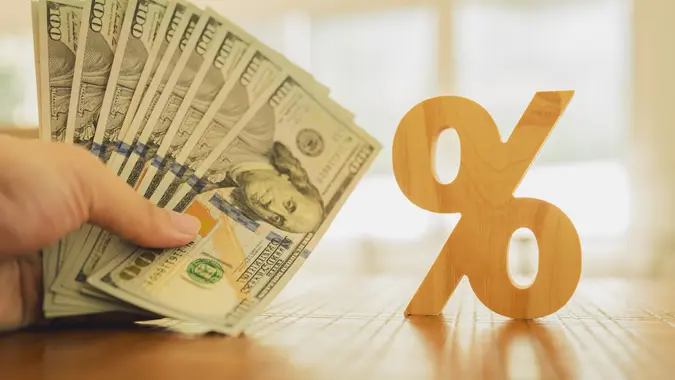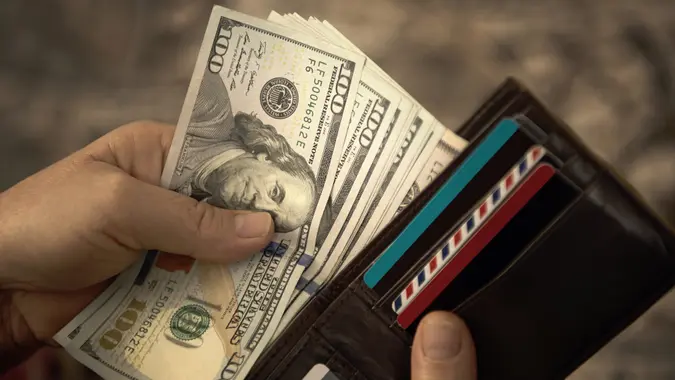Got $1K Saved? Here’s What Experts Say To Do With It in 2026

Commitment to Our Readers
GOBankingRates' editorial team is committed to bringing you unbiased reviews and information. We use data-driven methodologies to evaluate financial products and services - our reviews and ratings are not influenced by advertisers. You can read more about our editorial guidelines and our products and services review methodology.

20 Years
Helping You Live Richer

Reviewed
by Experts

Trusted by
Millions of Readers
As 2026 barrels this way, it may bring with it a very different economic landscape from 2025. Higher prices, steeper costs of living and questions about the fate of interest rates could offer different opportunities for your money.
If you’ve managed to save $1,000 or more (on top of an emergency fund) experts explained some of the best things to do with it next year.
Prepare For a New Economic Environment
The smartest thing to do is to think ahead to plan for the new economic environment, according to Jack Fu, co-founder and managing director at Draco Capital Partners. “In 2026, interest rates may be relatively higher, and market volatility might be more common compared to previous years.” Additionally, “geopolitical change and supply chain adjustment” could continue to create an uncertain investing climate.
On the positive side, Fu said that if the Federal Reserve begins to cut rates, capital may flow back into equities and growth-oriented assets. AI and renewable energy investment trends may also bring new areas of growth.
Invest It Wisely
If you’re bringing $1,000 in savings into 2026 that you don’t need for an emergency fund, you should definitely consider investing it, Fu said.
“If you have no high-interest debt, think about dividing it between low-risk, short-term assets (like money market funds or high-yield savings) and long-term growth investments (like ETFs or stocks) to balance liquidity and long-term appreciation,” he recommended.
Take Risk Tolerance Into Consideration
However, Fu said a lot depends upon the individual investor’s risk tolerance and time horizon.
“For those investors seeking stable returns, consider investment-grade bond ETFs as insulation against inflation,” he said.
For those with a longer time horizon, placing some of the money in actively managed ETFs could allow an investor to “potentially profit from more opportunities than passive index funds.”
Pay Down High-Interest Debt
If you hold money in savings but you’re also carrying any high-interest debt, you might be surprised that it makes more sense to pay down the debt first, Fu said.
“Usually, the interest rate on unsecured debt is much greater than the return you can realistically anticipate from investing, so I’d prioritize paying off the debt.”
Though it may not feel like money going out is an “investment,” Fu said, “This is a sure return equal to the interest saved without taking on investment risk.”
Invest In a Side Hustle
Aaron Razon, a personal finance expert at Coupon Snake, feels that the smartest move with $1,000 in 2026 is investing in bringing in more income.
“I believe the best way they can use this money to promote their financial growth would be to invest in a side hustle idea that can be sustained,” he said. This will help to ensure that they have a steady flow of income.
Stable, Risk-Free Investments
For those who don’t want to take risks with that $1,000, Razon suggested going the “safest and most stable route … especially given the shaky economic landscape.” Good options would include certificates of deposit (CDs) and U.S. Treasury bills or bonds.
“Although these options typically offer lower returns, they are a good place to invest especially in times when you can’t be certain of how the economy would perform,” Razon said.
Dip Your Toe Into Crypto
If you’ve been toeing the line about whether to invest in crypto, Ravi de Silva, founder of de Risk Partners, suggested it may be time.
“We’re at a point where opportunity and complexity are rising together,” de Silva said. “With pensions now able to include crypto, it’s worth considering this asset class within a diversified, well-managed strategy.”
Of course, de Silva pointed out that it’s always important to consult a financial advisor or professional who understands both your goals and today’s regulatory environment.
Does Age Factor Into It?
Your age and stage in life can also change how you save and invest. Fu suggested:
- Gen Z and younger investors can withstand more volatility, so a higher portion may be allocated to growth-type assets.
- Gen X and mid-career folks may favor a greater portion in capital preservation and steady income.
- Near retirees should focus on capital preservation and liquidity, e.g., through short-term bonds, CDs or money market funds.
Avoid These Mistakes
What you should not do is put all your money in one “basket” — so diversify as much as possible, Fu urged. Additionally, if you need your funds to remain liquid, don’t tie them up in long-term assets.
Lastly, he said selling stock too soon because of short-term market fluctuations can forfeit the advantages of long-term compounding.
Set Clear Goals
While any of these options can produce good financial results, Razon warned that the best way to grow any amount of money is to set clear goals.
“Some make the mistake of only thinking of how they can spend this money, with vacation and luxury items top on their lists,” he warned. However, adopting a saving and investing mindset as a priority can allow you to achieve more monumental financial goals.
 Written by
Written by  Edited by
Edited by 

























